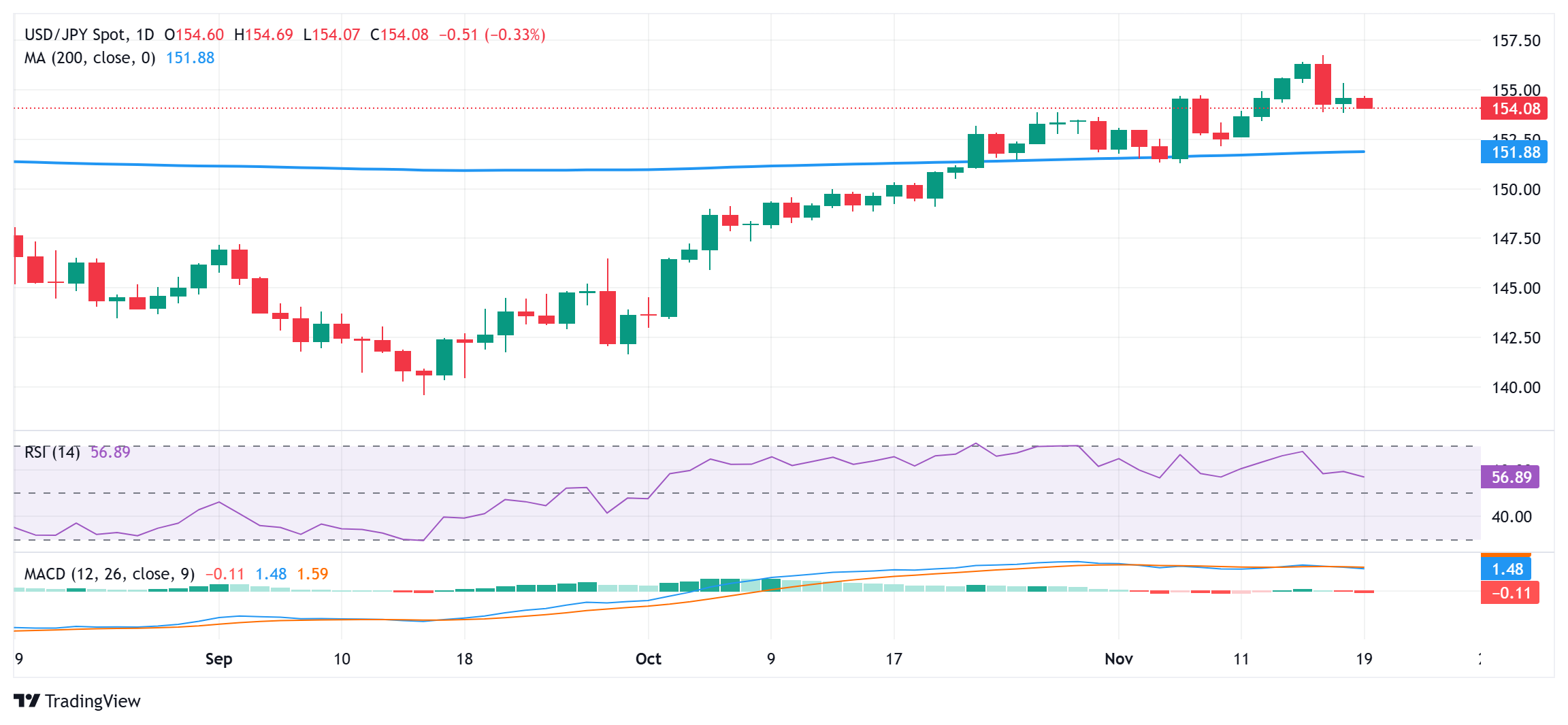Japanese Yen edges higher against USD; bulls seem non-committed
- The Japanese Yen strengthens amid intervention fears and retreating US bond yields.
- The USD remains on the defensive below the YTD peak and also weighs on USD/JPY.
- The BoJ rate-hike uncertainty might cap the JPY gains and offer support to the pair.
The Japanese Yen (JPY) ticks higher against its American counterpart during the Asian session on Tuesday, albeit it lacked bullish conviction in the wake of the uncertainty over the timing of another interest rate hike by the Bank of Japan (BoJ). Apart from this, the risk-on mood – as depicted by a generally positive tone around the equity markets – might contribute to capping the safe-haven JPY.
That said, geopolitical risks and softening US Treasury bond yields could prevent a significant downside for the lower-yielding JPY. Furthermore, speculations that Japanese authorities could intervene to prop up the domestic currency might hold back the JPY bears from placing aggressive bets. The focus now shifts to the consumer inflation data from Japan and the global PMI prints, due later this week.
The Japanese Yen draws support from a combination of factors; upside seems limited amid BoJ uncertainty
- Bank of Japan Governor Kazuo Ueda said on Monday that the economy was progressing towards sustained wages-driven inflation, leaving the door open for further monetary policy tightening.
- Ueda, however, provided few clues on whether the BoJ would raise rates in December and said that the gradual approach to adjusting policy is contingent on economic activity and price trends.
- Geopolitical uncertainties stemming from the protracted Russia-Ukraine war and the ongoing conflicts in the Middle East offer some support to the safe-haven Japanese Yen amid intervention fears.
- Japan's Finance Minister Katsunobu Kato warned last Friday that the government will scrutinize the FX market with very high vigilance and take appropriate action against excessive moves.
- A modest pullback in the US Treasury bond yields prompted some follow-through US Dollar profit-taking, after the post-US election blowout rally to a fresh year-to-date peak set last week.
- US President-elect Donald Trump's incoming administration is expected to focus on lowering taxes and raising tariffs, which could stoke inflation and limit the Federal Reserve's ability to cut rates.
- A slew of influential FOMC members, including Fed Chair Jerome Powell, recently suggested caution in cutting rates, which, in turn, favors the USD bulls and should cap the lower-yielding JPY.
- Japan's National Consumer Price Index (CPI) is due for release on Friday and will influence the JPY price dynamics ahead of the global manufacturing and service sector PMI prints.
USD/JPY might continue to attract dip-buyers near 153.85 pivotal support, bullish potential seems intact

From a technical perspective, the USD/JPY pair's failure to find acceptance above the 155.00 psychological mark on Monday and the subsequent pullback warrants caution for bullish traders. Spot prices, however, might continue to find support near the 153.85 region on the back of positive oscillators on the daily chart. Some follow-through selling should pave the way for additional losses towards the 153.25 region en route to the 153.00 mark and the next relevant support near the 152.70-152.65 area. A convincing break below the latter might expose the very important 200-day Simple Moving Average (SMA) resistance breakpoint, now turned support, currently pegged near the 151.90-151.85 region.
On the flip side, the 155.00 mark, followed by the overnight swing high, around the 155.35 region. A sustained strength beyond the latter will reaffirm the near-term positive outlook, which should allow the USD/JPY pair to surpass the 155.70 intermediate hurdle and aim towards reclaiming the 156.00 round figure. The momentum could extend further towards retesting the multi-month top, around the 156.75 region touched last Friday.
Japanese Yen FAQs
The Japanese Yen (JPY) is one of the world’s most traded currencies. Its value is broadly determined by the performance of the Japanese economy, but more specifically by the Bank of Japan’s policy, the differential between Japanese and US bond yields, or risk sentiment among traders, among other factors.
One of the Bank of Japan’s mandates is currency control, so its moves are key for the Yen. The BoJ has directly intervened in currency markets sometimes, generally to lower the value of the Yen, although it refrains from doing it often due to political concerns of its main trading partners. The BoJ ultra-loose monetary policy between 2013 and 2024 caused the Yen to depreciate against its main currency peers due to an increasing policy divergence between the Bank of Japan and other main central banks. More recently, the gradually unwinding of this ultra-loose policy has given some support to the Yen.
Over the last decade, the BoJ’s stance of sticking to ultra-loose monetary policy has led to a widening policy divergence with other central banks, particularly with the US Federal Reserve. This supported a widening of the differential between the 10-year US and Japanese bonds, which favored the US Dollar against the Japanese Yen. The BoJ decision in 2024 to gradually abandon the ultra-loose policy, coupled with interest-rate cuts in other major central banks, is narrowing this differential.
The Japanese Yen is often seen as a safe-haven investment. This means that in times of market stress, investors are more likely to put their money in the Japanese currency due to its supposed reliability and stability. Turbulent times are likely to strengthen the Yen’s value against other currencies seen as more risky to invest in.

